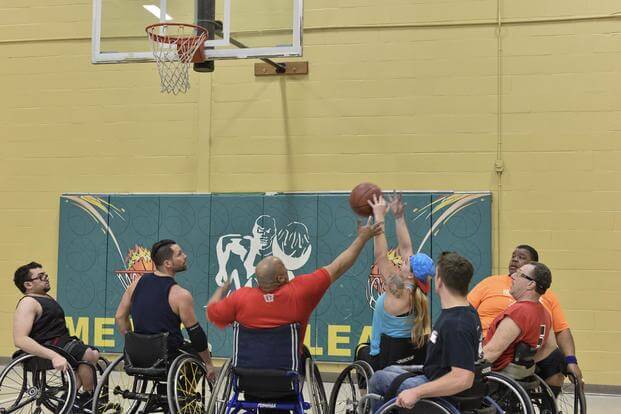Defense Secretary Jim Mattis' controversial new "deploy or out" policy, which requires troops to become deployable within 12 months or face separation, comes with a built-in exemption for the combat wounded.
But in designated "wounded warrior" units maintained by the services, those recovering from combat-related illness and injury form an increasingly small percentage of the total population.
And those whose conditions are not directly related to combat have no automatic protection from the deploy-or-out mandate, Pentagon officials say.
Air Force Maj. Carla Gleason, a spokeswoman for the Pentagon, said these troops will fall under the same guidelines as the general military population, and must become deployable within a year or be separated. Exceptions, she said, will be made on a case-by-case basis at the top level of service leadership.
"The individual service would have to decide whether or not to give you a waiver," she told Military.com. "We're envisioning the service secretary having to sign on the dotted line. There won't be a blanket policy."
The two-page policy, finalized Feb. 14, directs each service to begin mandatory processing of non-deployable service members for administrative separation by Oct. 1. Individual services are now absorbing the guidance as the Pentagon completes a more comprehensive DoD instruction on reporting and retention of the non-deployable.
Mattis has said the policy is designed to ensure fairness, and to keep some troops from having to shoulder an undue deployment burden while others fail to deploy.
"You're either deployable, or you need to find something else to do. I'm not going have some people deploying constantly and then other people, who seem to not pay that price, in the U.S. military," Mattis told a gaggle of reporters during a recent trip to Europe.
But the memo, at least, does not spell out how every contingency will be handled. Air Force Secretary Heather Wilson told reporters at a round table last week that the service is still working on how to execute the policy in light of a small number of "non-deployable" career fields.
Scant communication has also heightened confusion about who is and isn't a candidate for separation.
At the Marine Corps' Wounded Warrior Regiment, which supervises two Wounded Warrior Battalions located at Camp Lejeune, North Carolina, and Camp Pendleton, California, a spokesman initially said he believed all the troops assigned to the units would receive an automatic waiver.
Capt. Andrew Bolla, a public affairs officer for the regiment, told Military.com there are 760 Marines on active duty assigned to one of the Wounded Warrior Battalions, with 456 on-site and 304 receiving care at their parent units.
Of those troops, 12 percent are recovering from an illness or injury related to combat; the others are recovering from a variety of injuries and illnesses requiring a period of long-term care.
"There's been a shift [in the Wounded Warrior Battalions' population] from the catastrophic combat wounded to slightly more senior in rank, slightly older," Bolla said.
Currently, 62 percent of troops are assigned to the battalions for orthopedic issues.
Bolla said the units are reserved for troops expected to require 90 days or more of complex care. Casualty reports across the Marine Corps are automatically flagged to the Wounded Warrior Regiment. Leadership reviews each case and decides whether the service member would benefit from being assigned to a unit.
In 2016, service members attached to the Wounded Warrior Regiment spent an average of 13 months there before being transferred back to their parent units or being processed out, Bolla said.
As the number of actual combat-wounded troops has dwindled in recent years with the formal close of the wars in Iraq and Afghanistan, the Wounded Warrior Regiment, first activated in 2007 as the wars were ongoing, opted to continue its mission.
Col. Scott Campbell, then the commander of the regiment, told Military.com in 2016 that the unit allowed the Marine Corps to keep faith with troops requiring complex care for various reasons.
It also shifts burden away from units that would otherwise have to attend to these troops while meeting operational requirements.
The other services also maintain their own versions of wounded care units that extend beyond those with combat-related injuries.
The Air Force has about 3,200 non-deployable personnel in wounded warrior programs, Lt. Gen. Gina Grosso, deputy chief of staff for Manpower, Personnel and Services, said recently.
The Navy's Wounded Warrior-Safe Harbor program served 4,665 as of December 2016, according to a command report, with wounds, illnesses and injuries ranging from gunshot wounds and explosions to pedestrian accidents and cancer.
An Army official, who asked that his name not be used so he could speak about predecisional matters, said the service's Warrior Care and Transition Program intends to ask for a waiver covering all 2,082 soldiers currently assigned to the program and its 14 Warrior Transition Units.
At the program's peak, 12,000 soldiers were receiving care, the official said.
As with the Marine Corps' wounded care program, troops assigned to the Army's WCTP spend about a year, on average, with the program, though the average duration of assignment has been steadily falling in recent years.
Of the current population, 325 are receiving care due to a combat-related condition or injury, including post-traumatic stress, the official said.
The official said the Army's program is likely to remain an enduring unit, and the Pentagon's "deploy-or-out" policy should acknowledge the value of what warrior care and transition programs do as wounded, ill and injured troops transition out of the force or back to duty.
"At the end of the day, we're always going to have a base level of people who are going to be hurt," he said.
The final policy containing the deploy-or-out rule, he said, could help by "clearly identifying what the standards are and giving commanders some latitude for subjective calls."
-- Hope Hodge Seck can be reached at hope.seck@military.com. Follow her on Twitter at @HopeSeck.












